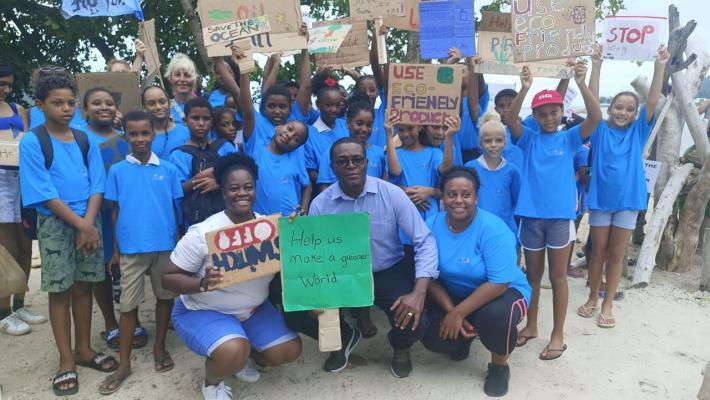Africa-Press – Seychelles. A new report published by the Seychelles Conservation and Climate Adaptation Trust is exploring the untapped economic potential of seagrass meadows in Seychelles, from blue carbon finance to fertiliser production.
The report, titled ‘Identify and Test Revenue Generating Possibilities of Seagrass in Seychelles’, was authored by Ginny Elizabeth and Audrey Zelia Derjacques, and funded under the Seychelles Conservation and Climate Adaptation Trust (SeyCCAT) Coastal Wetlands and Climate Change Project.
It is the first formal assessment to test how seagrass could support Seychelles’ marine conservation efforts through revenue generation. Despite covering over 140,000 hectares and storing an estimated 16.6 teragrams of carbon, seagrass ecosystems remain underutilised in national financing strategies.
The study identifies carbon trading, environmental levies, user fees, and commodification of seagrass bycatch as potential avenues for income. However, it also highlights critical gaps in legal frameworks, data, and scientific capacity.
Blue carbon at the centre
The report underscores growing international interest in blue carbon, the carbon stored in coastal ecosystems such as seagrass, mangroves and salt marshes, as a new frontier in the global carbon market. Seychelles committed to protecting 100% of its seagrass habitats by 2030 under its Nationally Determined Contributions (NDCs) to the Paris Agreement. The protection target is enshrined in policy, but not yet implemented in law or supported by a dedicated national action plan.
The World Bank estimates voluntary carbon market prices could rise from USD 15 to 24 per tonne in 2022, to USD 40 to 65 by 2040, creating a financial incentive to monetise carbon stored in seagrass. Yet, as the report notes, carbon offset projects must prove “additionality” — that the carbon would not have been preserved without the project — which is challenging in Seychelles, where 99.5% of seagrass meadows already fall within marine protected areas.
Restoration projects are costlier and slower to yield carbon returns, while conservation projects face difficulty demonstrating additionality under international standards. A proposed pilot project on Praslin aims to test the feasibility of combining carbon credits with fisheries benefits through a community-driven design.
Beyond carbon, user fees and fertiliser
The report explores alternative revenue models beyond carbon markets. These include extending existing environmental levies to coastal developers and marine users operating in seagrass zones, and increasing marine park user fees for activities such as turtle watching and snorkelling in seagrass habitats.
Another potential opportunity is the use of seagrass washed ashore, currently viewed by some as a nuisance, as a raw material for organic liquid fertilisers. Similar models exist in Zanzibar and Puerto Rico. However, the report warns against rushing into commercialisation without a proper regulatory framework or environmental safeguards.
Policy and institutional barriers
Despite strong policy statements, the country currently lacks a regulatory framework for blue carbon trading. Seagrass remains unclassified as a protected species, and areas outside MPAs have no legal safeguards. Land tenure and carbon rights also remain unclear, which could hinder investment.
The report calls for the government to: develop a formal blue carbon policy, finalise a national NDC action plan, establish clear carbon ownership and benefit-sharing rules, improve cross-agency coordination, and build local scientific and technical capacity. A cross-ministerial decision-making body, and a dedicated blue carbon working group, are also recommended to fast-track progress.
Community-based approach
Community-led conservation is a recurring theme in the report, with seagrass meadows providing key nursery grounds for commercially important species such as rabbitfish and sea cucumbers. The Au Cap Reserve and Baie Ste Anne, Praslin, are cited as prime candidates for pilot projects integrating conservation, fisheries enhancement, and awareness campaigns.
SeyCCAT states that such projects can play a critical role in educating communities, strengthening marine resilience, and unlocking sustainable revenue, even if blue carbon finance remains a long-term prospect.
Compiled by Sunny Esparon
For More News And Analysis About Seychelles Follow Africa-Press






